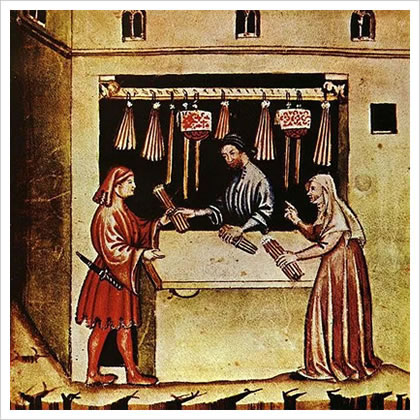The Amazing History of Candles!
The Early Origins of Candles...

Candles have been used for thousands of years not only to simply illuminate but also to celebrate particularly religious events. The earliest incarnation of a candle dates back well over 5,000 years to the ancient Egyptians who made 'rushlights' by soaking reeds in animal fats. However it was the Romans who are generally credited with developing the 'wicked candle' - although chances are the same discovery was happening all over the World from South America to China, the Middle East to Europe.
Ancient Romans would dip rolled papyrus into melted tallow (beef fat) and later on beeswax. The resulting 'candles' were used to light their homes, to assist travellers and became a centrepiece in their worship ceremonies.
Candles have played an important role in virtually every religion for centuries. Ceremonies such as Hanukkah or the 'Jewish Festival of Lights' which originated around 165 B.C. is celebrated with the nightly lighting of candles in a Menorah, a 'U' shaped seven branched candelabra. There are several Biblical references to candles, and the Emperor Constantine is reported to have called for the use of candles during an Easter service in the 4th century.
Candles of the Middle Ages...
Around the 13th century candle making became a 'Guilded Craft' although still the most common candle were those made from tallow which was cheap and plentiful. Candle Makers (known as Chandlers) went from house to house making candles from kitchen fats saved for the purpose. As you might imagine though, tallow candles smelt awful and billowed acrid, greasy smoke. It was the advent of beeswax candles that changed things as they burned much more cleanly with a pleasant, sweet smell. However beeswax candles were incredibly expensive by comparison to tallow and few people other than the very wealthy and churches could afford to burn them.
Advances in Candles...
The 19th century brought major advances in candle making, not least the development of stearin wax in the 1820's and later on in the 1830's the introduction of mechanised production which made candles so much cheaper to buy. Twenty years later saw the development of paraffin wax, making candles totally clean burning and more economical to produce than ever before. However this discovery would be relatively short lived after Thomas Edison patented the first commercially successful lightbulb in 1879 and candle sales slowly declined.
Today's Candles...
The 20th century saw a renewed popularity in candles and by the mid 1980's consumer interest was ignited (excuse the pun!) by an upsurge in candles of different shapes, colours sizes and vessels... no longer were they a practical necessity, candles became an item of luxury!
However it was the scented candle that really changed the fortunes of Chandlers worldwide. Although scent has been added to candles for nearly as long as they have existed, no longer was it needed to cover up the unpleasant acrid smell of tallow, instead fragranced candles were designed with aromatherapeutic qualities to complement modern life. Scents can be relaxing, uplifting, invigorating, refreshing and can even create a cosy environment. With more than a quarter of British households now buying luxury scented candles on a regular basis, the candles comeback is well and truly on it's way!

